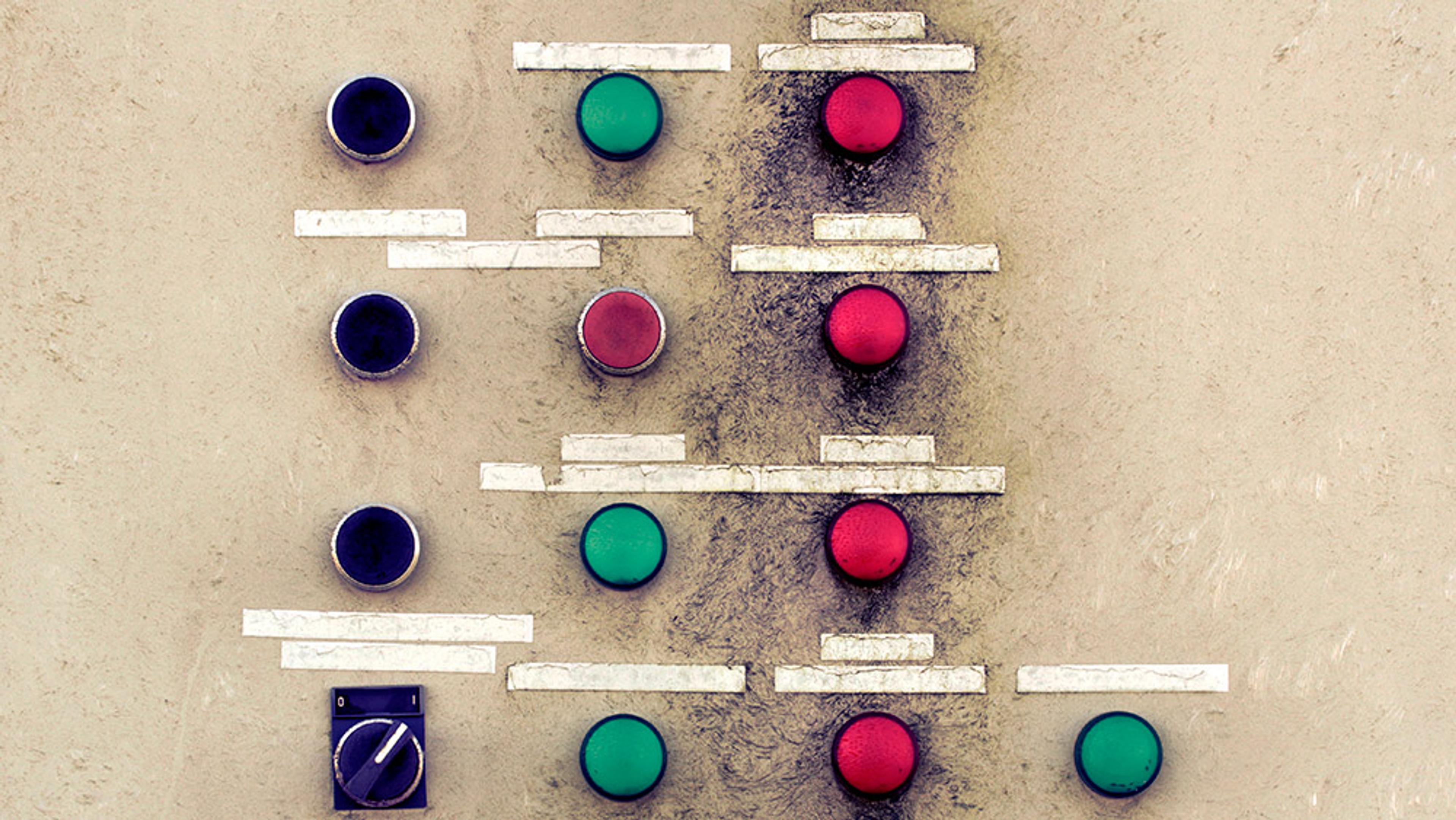The act of pushing a button is central to how we work, play and communicate, but opposition to buttons and what they represent has a long history. In 1903, a French nobleman, the Marquis de Castellane, lamented in a newspaper editorial:
It is no longer necessary to speak to be served. You step into a hotel, press the button, and a succulent luncheon appears suddenly before your delighted vision. Ten seconds later you feel chilly; you press another button, and presto! your fireplace is lighted up as if by magic. Electric buttons have become the masters of the world, overcoming distance, doing away with the necessity for forethought and, for that matter, for thought at all.
Like many observers at the turn of the 20th century, caught between romantic optimism and moral panic over industrialisation, de Castellane wondered: ‘Do you not think that this prodigious diffusion of mechanism is likely to render the world terribly monotonous and fastidious? To deal no longer with men, but to be dependent on things!’ Pushing buttons made life too easy, too simplistic, or too rote, when a single finger-action could conjure one’s desires. For de Castellane, a reliance upon machines tipped the scales in favour of ‘things’ over human beings, and he anxiously predicted that ‘the result of too much simplification will be to suppress the joys of life altogether’.
This distaste for buttons, combined with a nostalgia for a pre-button past and a belief that action involved directed contact with the world, continued to bubble up in popular discourse well into the 1900s. In the story The ‘Push-the-Button Man’ (1924) by Frank Dorrance Hopley, the protagonist, Carey, begins by being enamoured with the prospect of sitting behind a desk and pushing buttons all day to command others to do his work, but ultimately he has to excise buttons from his life to reclaim it through a dramatic act of anti-button sabotage:
He sat down at his desk and his eyes rested upon the block of call buttons which had so nearly proved his undoing. There were 12 buttons; white, black, and red. Carey took out his knife and cut the cord that connected them with the other desks. The block fell to the floor; Carey picked it up, took a sheet of paper from a pigeon hole and wrote: ‘I am sending you the buttons from my desk, as I shall not want them any more. Keep them as a souvenir of the past. Will see you tonight and explain.’
By literally and figuratively severing his connection to the buttons on his desk, Carey awakened to the error of his ways and embraced the American ethos of the ‘self-made’ man: ‘It was going to be worth while; out there, where men made themselves; where they held their destinies in their own hands; where merit, alone, won; and – where no one ever pushed buttons.’
Hopley’s story sounded a warning against push-button managers and bureaucracy, arguing for self-made individuals who clawed their ways to the top. Buttons represented entitlement and laziness, and button-pushing signified a hierarchical and unequal management style. Like de Castellane before him, Hopley imagined that the only way out for his main character (and for society more broadly), was to return to a world devoid of buttons.
The social, technical and historical circumstances of the late-19th and early 20th centuries particularly sharpened these criticisms toward button-pushing, even as new technologies aimed to massively increase efficiency through automation of previously laborious processes. Concerns over the use of human hands, for example, grew more pronounced as many innovations involved what the German critic Walter Benjamin in 1939 described as ‘a single abrupt movement of the hand [that] triggers a process of many steps’ in which ‘a touch of the finger sufficed to fix an event for an unlimited period of time’. Engineers boasted about replacing difficult, hand-operated machinery with easy-to-use electrical machinery: cranes and hoists filled in for conveyors and chutes, while pushbuttons took the place of ‘laborious hand-actuated levers’ and various kinds of ‘pulls’.
By contrast, for critics of these rapid technological changes, carrying out an activity ‘by hand’ or ‘manually’ signified not only exerting greater effort, but also engaging in a fundamentally human activity. The writer Joe Mitchell Chapple in 1908 cited many significant religious and social instances of touching, whether for healing, intimacy, or in demonstrating the ‘personal touch’. In this regard, button-pushing – using machines to replace manual labour, handicraft and communication – threatened to destabilise entrenched associations between hands and humanness. This anxiety was foreshadowed by Karl Marx and Friedrich Engels, who in their Communist Manifesto (1888) worried that:
Owing to the extensive use of machinery, and the division of labour, the work of the proletarians has lost all individual character, and consequently all charm for the workman. He becomes an appendage of the machine, and it is only the most simple, most monotonous, and most easily acquired knack, that is required of him.
By denigrating factory technologies for causing workers to become ‘appendages’ – an atrophied hand merely added on to provide a rote function – Marx and Engels suggested that machines contributed to human beings’ alienation from production and from the products of their labour. Buttons represented this quintessential triumph of technical labour over human labour. But not all button-pushing was deemed bad: in 1888 Kodak’s advertising slogan for the Brownie camera (‘You press the button, we do the rest’) relied on the simplicity of the process for the user, and democratised photography for those who had previously been kept away because of the complicated process of developing and printing photographs. For the many millions who took up the Brownie camera, the button-pushing was what they wanted and celebrated.
Cold War fears centred around a single button-push that would set a nuclear bomb on an unstoppable path
At their best, early pushbuttons made light instantly appear, preventing falls in the dark. They warned of emergencies such as fires, putting help in closer reach. They honked automobile horns, and called for service in hotels and well-to-do dining rooms; they made elevators appear at a whim, and put photography within reach of the masses. Prefiguring the present-day internet age, one author in 1895 imagined an ‘ideal future when life shall consist of sitting in a chair and pressing buttons’. The act of pushing a button signified comfort, convenience and control, the heady values of industrialisation, much as it could also represent slothfulness, deskilling or alienation.
These complaints carried on into the 20th century, with the French sociologist and philosopher Jean Baudrillard in 1968 lamenting that buttons, levers and the like had ‘very nearly turned [humans] into the actors in a global process in which man is merely the role, or the spectator’. This role of alienated ‘spectator’ suggested human impotence, relegating button-pushers to look on as machines carried out the supposed real action. Not coincidentally, at this time, Cold War fears of imagined pushbutton warfare centred around the paranoia of a single push that would set a nuclear bomb on an unstoppable path. Although a Russian or an American finger could act as a trigger, the real power seemed to lie with the bomb itself, as humanity would watch helplessly while nuclear annihilation unfolded.
Today, while technologies have changed significantly from Baudrillard’s time, let alone Marx’s, pejoratives about ‘button pushers’ are still common. Arguments against drone warfare – or conflict-by-button – often centre on over-simplifying, distancing and dehumanising the grave action of taking lives. In other contexts, charges against button-pushing take on a similar tenor, in the vein of critiques against ‘button mashing’ in gaming, ‘button pushers’ in photography and electronic music, and ‘couch potatoes’ content to laze away the day with a television remote control. In each of these cases, the button-pusher’s engagement is perceived as detached and unskilled, and much of the criticism centres on the very fact that buttons facilitated these forms of distance and disengagement from other aspects of human life.
Despite these myriad complaints, buttons remain ubiquitously present. Graphical user-interfaces on web pages and apps feature all kinds of buttons for tapping and touching. Buttons feature prominently on social media to express emotions – from ‘like’ and ‘love’ to ‘sad’ or ‘wow’. Physical buttons continue to appear on elevators, coffee-makers, remote controls and steering wheels. That being said, critics of buttons seem to hanker after a button-free world. Indeed, some recent technological designs have eschewed buttons in favour of gesture-based control (such as the Microsoft Kinect or Nintendo Wii) or voice activation (in the case of Alexa for Amazon or Siri for Apple).
In other instances, such as Apple’s latest iPhone, the company boasts about replacing the ‘home’ button, a fixture of previous designs, with facial recognition: ‘You look at it to unlock it,’ noted Phil Schiller, an Apple marketing executive, at the phone’s launch. ‘Your phone knows what you look like, and your face becomes the password.’ In a similar vein, the Polish interface designer Wojciech Dobry has argued that it’s ‘time to think button-less’, where user-interface architects imagine a ‘button-less’ utopia where people can simply clap to express enthusiasm, use their voices to execute a command, or drag and drop items with their fingers on a slick, glass screen. Dobry surmises that buttons, a vestige of the 19th century, need not hang on far into the 21st century.
These efforts propose that the world might be better off without pushbuttons by moving to more ‘natural’ interactions with the technologies of everyday life. These responses reflect the fact that buttons most certainly have certain technical limitations. They can, for instance, constrain users’ choices to limiting binaries such as on/off, yes/no, or start/stop, rather than encouraging a range of options. In some situations, a dial, clap or voice command might indeed work better than a button – and issues of usability should come to the fore of any design conversation.
However, what corporations and designers often fail to recognise is that complaints about buttons have less to do with buttons themselves than with the social and technical contexts in which those buttons exist. By looking at the subtexts behind complaints about buttons, whether historically or in the present moment, it becomes clear that manufacturers, designers and users alike must pay attention to why buttons persistently engender critiques. Such negativity tends to involve one of three primary themes: fears over deskilling; frustration about lack of user agency/control; or anger due to perceptions of unequal power relations.
How many times should one strike an elevator button? Does that button do anything?
First, despite the benefits that have resulted from delegating manual labour to machines, societies have long grappled with the question of whether those machines deskill human beings and make them obsolete. What Engels and Marx called an ‘appendage’ and Baudrillard called a ‘spectator’ are bodies made unnecessary, who exist solely to support a machine’s functions. Buttons do not inherently or inevitably deskill workers; in fact, a great deal of reskilling has been required over the past 100 years or more to teach people how to push the right buttons in the right contexts. One need only look at the complicated interface of an airplane cockpit, a car dashboard or a manufacturing facility’s control room to understand that button-pushing quite often necessitates an intimate knowledge and cultivated bodily practice.
Attendant to concerns about skill, when users do not understand how buttons work in a particular context (quite a common problem), they often experience frustration at the feeling that they are not truly in control – that somehow the machine worked independently from their finger pushes. Some buttons, at a push, seemingly do nothing at all, leaving the user dumbfounded and without recourse. Buttons can also, in their opaque design, prompt questions of user agency and efficacy. For instance, how many times should one strike an elevator button to hurriedly get to one’s floor? Does that button do anything? Likewise, the aptly named ‘placebo button’ references the fact that many buttons remain in existence, such as crosswalk buttons, to give users a false sense of agency, given that computers now automate such tasks. Buttons’ lack of feedback can leave maddening questions in their wake about ‘authentic’ control.
Last – and perhaps most vexing – people excoriate button-pushing when they perceive that they are being pushed into action while someone else gets to do the pushing. Returning once more to Hopley’s story of Carey, it becomes evident that the author feared the ‘pushbutton manager’ because he represented an abuse of power. Witnessing the rise of scientific management and bureaucratic practices in offices, Hopley blamed buttons for creating oppressive distance between managers and lower-level employees. These managers could sit comfortably at their desks espousing orders with a push, while those below them unceremoniously toiled. Similar complaints cropped up among servants, who lamented their poor treatment at the hands of housewives. Such inequities persist: when one pushes, taps or clicks a button to order a product online, it is not the button that delivers that product but rather an assembly of (often poorly compensated) human labour that must respond on demand, from manufacturing and fulfilment through delivery. Buttons work through the magic of making things (and people) appear at one’s beck and call. However, that magic often belies strikingly unequal power dynamics.
These scenarios, which have much more to do with social relations than with buttons themselves, suggest how the act of pushing a button gets embroiled in cultural and political circumstances of a particular moment. After surveying more than a century of wild optimism and moral panic about pushbuttons, it becomes apparent that it is time to put an end to the ways that buttons (and perhaps all interfaces) get glamorised or demonised in people’s talk, writing and cultural imagination. To rethink the roles of buttons is not so much to decide if they are ‘good’ or ‘bad’, but rather to look beyond their iconic function in popular culture and popular discourse. Refocusing attention from whether buttons should exist to how they function socially and technically in specific contexts opens up a realm of new questions about interface interactions in everyday life. To give a few examples: it matters whether buttons get put behind glass, whether children get to touch them at museums, and whether an intercom button gets installed at a patient’s bedside. Who gets to touch and under what circumstances? Who is made to heed the button-pusher’s demands?
A world without buttons would offer no utopian antidote to the problems that often plague communication, work and play, both through and with technologies. Every interface requires users to learn about and habituate their bodies to a set of what at first seem very unnatural gestures – and every interface gets embedded and mobilised in social circumstances in ways that can support or disincentivise users’ agency. Touchscreen interfaces raise concerns about safety, as users must devote much of their attention to visually engaging with the screen rather than feeling about for a raised surface with their fingers. Facial-recognition interfaces carry with them attendant ethical questions, and some worry that tools of this kind indicate ‘another step toward the end of anonymity’, and invite greater surveillance by both corporations and government entities. Moving toward these forms of interaction merely invites new puzzles and negotiations.
Rather than eschew buttons for the next shiniest interface as though it were a panacea, the task, then, becomes to imagine a world with buttons that also prioritises authentic user-engagement, transparency and feedback – a world that is sensitised to the politics and privileges associated with pushing.






